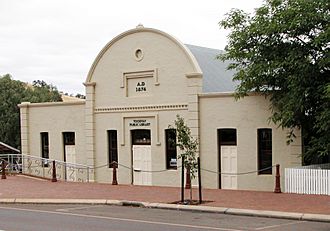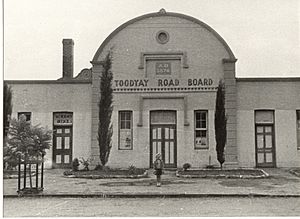Toodyay Public Library facts for kids
Quick facts for kids Toodyay Public Library |
|
|---|---|
 |
|
| Former names | Mechanics' Institute, Newcastle Roads Board, Toodyay Roads Board |
| General information | |
| Architectural style | Victorian Free Classical / Eclectic |
| Address | 96 Stirling Terrace |
| Town or city | Toodyay |
| Coordinates | 31°33′01″S 116°28′11″E / 31.5503°S 116.4696°E |
| Completed | 1874 |
| Design and construction | |
| Main contractor | Thomas Davey assisted by George Hasell |
| Type | State Registered Place |
| Designated | 21 January 1997 |
| Reference no. | 2566 |
| References | |
| Toodyay municipal inventory | |
The Toodyay Public Library is a historic building located on Stirling Terrace in Toodyay, Western Australia. It has served the community of Toodyay for many years, first as a place for learning and later as a public library.
Contents
How the Library Started
The idea for a library in Toodyay began with a group called the Newcastle Mechanics' Institute in 1866. This was a place where people could learn and read. Charles Harper was chosen as its first leader. However, by 1869, not enough people were supporting it, and it started to fade away.
Another group, the Toodyay Young Men's Reading Club, started in 1871. They met in the local schoolroom and held talks on different topics. For example, one talk was about the famous writer Charles Dickens.
In 1873, people held a special "tea-meeting" with food and singing. They wanted to combine the Mechanics' Institute and the Reading Club. Their goal was to build a new place for this combined group.
Building the Library
The Mechanics' Institute Building (1874-1921)
A local hotel owner, Mr. Leeder, helped make the building possible. He offered good terms for its construction, and the money borrowed was paid back in 20 years. Thomas Davey was chosen to build it in 1874. The new building became the home of the revived Newcastle Mechanics' Institute. It was one of the first public buildings in the new town of Toodyay.
In 1877, the first local council, the Newcastle Municipal Council, was elected. They started holding their meetings in the Mechanics' Institute hall. By 1886, they were paying a small rent to use the hall.
More features were added to the building in 1886, like a stage and a fireplace. A new piano was bought, and more books were added to the library. People paid a small yearly fee to be members of the Mechanics' Institute. This money helped buy newspapers and books, pay for heating, and pay the librarian's salary. Concerts and other events also helped raise money. In 1886, there were 33 members.
The hall was used for many public events in the late 1800s. In 1890, a free dance was held to celebrate Proclamation Day, with 150 people attending. In 1892, a special show with a magic lantern (an early type of projector) was held. The local council sometimes moved their meetings to hotels if the hall was being used for other events.
The building was repaired in 1894 because it was getting old. In 1897, the Mechanics' Institute Committee added more parts to the building. These additions are thought to be the two side sections and possibly the curved front we see today.
In 1899, a meeting about women's suffrage (the right for women to vote) was held at the Mechanics’ Institute. Women were present at this important discussion.
In 1905, the Toodyay Club started its first meeting in the building. This club later built its own clubrooms, now known as Stirling House.
By 1906, the building was again in need of repairs. Not many people were joining, and the government had reduced its support. In 1907, the Newcastle Mechanics’ Institute got a boost when the government helped them buy new books. Jane Hasell became the caretaker and librarian. The Institute received many new books, and membership grew to over 100 people.
The Institute's money came from member fees, renting out the hall, and government help. Expenses included the caretaker's pay, repairs, and buying newspapers. Important people visited the Institute, like Sir John Forrest in 1910, who was a government leader. Also in 1910, Jessie Ackermann, a social reformer, spoke to women at the Institute, encouraging them to vote.
However, by 1916, the Institute was spending more money than it was making. Government support stopped in 1913, meaning fewer new books were bought. By 1921, people decided to close the Institute and sell its belongings. The money would go to the local hospital.
Community Hall (1921-1927)
After the Institute closed, its furniture and books were sold. But it was unclear who owned the building itself.
Even so, the building continued to be used for many community events. It hosted fundraising sales for St John the Baptist Church in the 1920s. Football teams used it for social gatherings, and a girls' gymnastics club met there. A room was even used to store training equipment for a local military group.
In 1926, the building and land officially became government property. It was then given to the Toodyay Road Board, which was like the local council at the time.
Toodyay Road Board (1927-1958)
The Toodyay Road Board used the building as their offices for many years.
Toodyay Public Library (1959-Present)
In 1959, the building was officially named the Toodyay Public Library. It continues to serve the community as a library today.
The building is recognized as an important historical site and is listed on the Australian Heritage Database.


